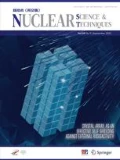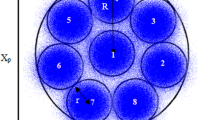Abstract
The high-intensity heavy-ion accelerator facility (HIAF) is under design at the Institute of Modern Physics (IMP) and will provide an intense ion beam for nuclear physics, atomic mass measurement research, and other applications. As the main ring of HIAF, the BRing accumulates beams to high intensity and accelerates them to high energy. To achieve high intensities up to \(1\times 10^{11}\) (\(^{238}\)U\(^{34+}\)), the injection gain of the BRing must be as high as 88. However, multiple multiturn injection supported by the electron cooling system takes a long time, causing substantial beam loss under a strong space charge effect. Hence, a two-plane painting injection scheme is proposed for beam accumulation in the BRing. This scheme uses a tilted injection septum and horizontal and vertical bump magnets to paint the beam into horizontal and vertical phase space simultaneously. In this paper, the two-plane painting injection parameters are optimized, and the resulting injection process is simulated using the Objective Ring Beam Injection and Tracking (ORBIT) code. An injection gain of up to 110.3 with a loss rate of \(2.3\%\) is achieved, meeting the requirements of BRing.













Similar content being viewed by others
References
J.C. Yang, J.W. Xia, G.Q. Xiao et al., High Intensity heavy ion Accelerator Facility(HIAF) in China. Nucl. Instrum. Methods B 317, 263–265 (2013). doi:10.1016/j.nimb.2013.08.046
C. Li, L. Sun, Y. He et al., Conceptual design of LEBT and RFQ for the HIAF linac. Nucl. Instrum. Methods A 729, 426–433 (2013). doi:10.1016/j.nima.2013.06.019
Y. Yang, L.T. Sun, X.Z. Zhang et al., Preliminary design of a LEBT for HIAF linac at IMP, TUPRO054, in Proceedings of IPAC2014, Dresden, Germany, pp. 1153–1155 (2014)
X. Gao, J.C. Yang, J.W. Xia et al., SHER-HIAF ring lattice design. Chin. Phys. C 38(4), 84–87 (2014). doi:10.1088/1674-1137/38/4/047002
L.J. Mao, J.C. Yang, J.W. Xia et al., Electron cooling system in the booster synchrotron of the HIAF project. Nucl. Instrum. Methods A 786, 91–96 (2015). doi:10.1016/j.nima.2015.03.052
C.R. Prior, HIDIF Horizontal–Vertical Multi-Turn Injection, HIDIF/RAL2 CLRC (Rutherford Appleton Laboratory, Chilton) (1997)
I. Hofmann, HIDIF-an approach to high repetition rate inertial fusion with heavy ions. Nucl. Instrum. Methods A 415(1–2), 11–19 (1998). doi:10.1016/S0168-9002(98)00512-9
L.J. Laslett, On intensity limitations imposed by transverse space-charge effects in circular particle accumulators, in Proceedings of 1963 Summer Study on Storage Rings, BNL-Report 7534, pp. 324–367 (1963)
D.H. Kim, B.T. Jang, Design and construction of the CERN LEIR injection septa, in 21st Particle Accelerator Conference (PAC 05), pp. 2690–2692 (2005)
S.Y. Lee, Accelerator Physics (World Scientific, Singapor) (2004), pp. 47–50
J. Galambos, J. Holmes, D. Olsen, ORBIT User Manual, SNS technical note (1999)
J. Galambos, S. Danilov, D. Jeon et al., ORBIT: A ring injection code with space charge (1999)
A.C. David, An Introduction to Genetic Algorithms For Scientists and Engineers (World Scientific, Singapore) (1999)
C.R. Houck, J.A. Joines, M.G. Kay, A Genetic Algorithm for Function Optimization: A MATLAB implementation. Ncsu, 22 (1998)
A. Chipperfield, P. Fleming, H. Pohlheim et al., Genetic algorithm toolbox for use with MATLAB (1994). http://www.pohlheim.com/Papers/tr_gatbx12/ChipperfieldFlemingPohlheimFonseca_tr_GATbx_v12.pdf
R.W. Hockney, J.W. Eastwood, Computer Simulation Using Particles (Adam Hilger, IOP Publishing, New York) (1988)
J.D. Galambos, A.U. Luccio, D.K. Olsen et al., A particle-in-cell model for space charge dynamics in rings, in 6th European Particle Accelerator Conference, Stockholm, Sweden, pp. 22–26 (1998)
Author information
Authors and Affiliations
Corresponding author
Additional information
This work was supported by the National Natural Science Foundation of China (No. 11505256).
Rights and permissions
About this article
Cite this article
Qu, GF., Chai, WP., Xia, JW. et al. Two-plane painting injection scheme for BRing of HIAF. NUCL SCI TECH 28, 114 (2017). https://doi.org/10.1007/s41365-017-0260-5
Received:
Revised:
Accepted:
Published:
DOI: https://doi.org/10.1007/s41365-017-0260-5




